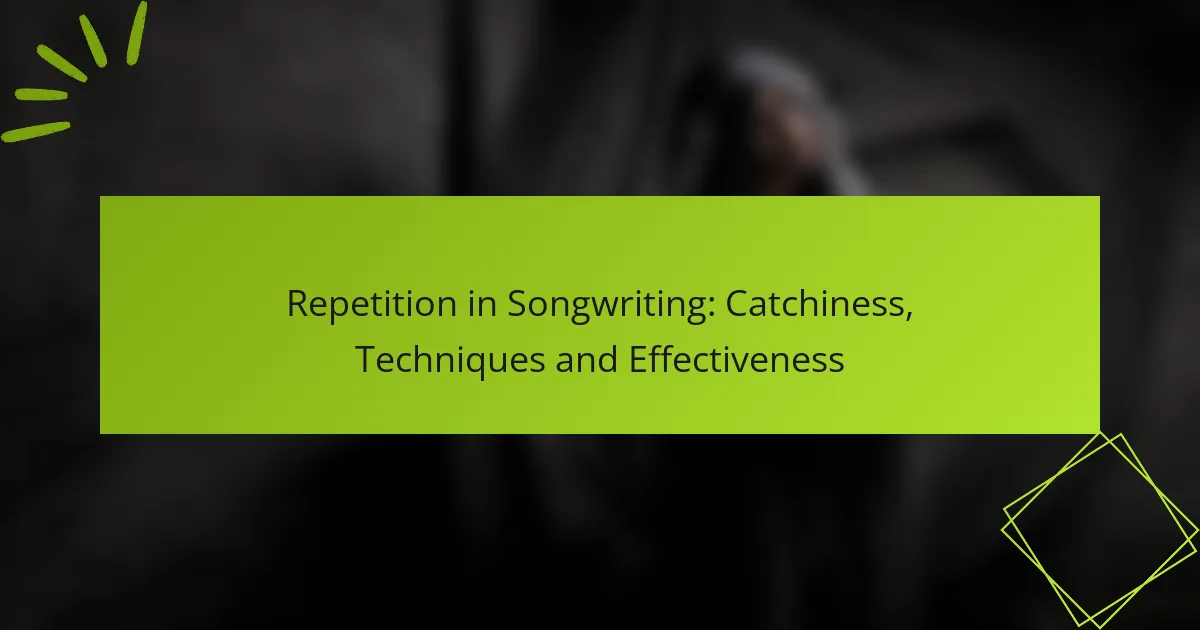Repetition plays a crucial role in songwriting by embedding catchy phrases and melodies in the listener’s memory, making songs more engaging and memorable. Techniques such as chorus repetition, motif variation, and call and response not only enhance a song’s structure but also deepen listener engagement. Ultimately, repetition fosters familiarity and emotional connection, increasing a song’s appeal and potential for success.
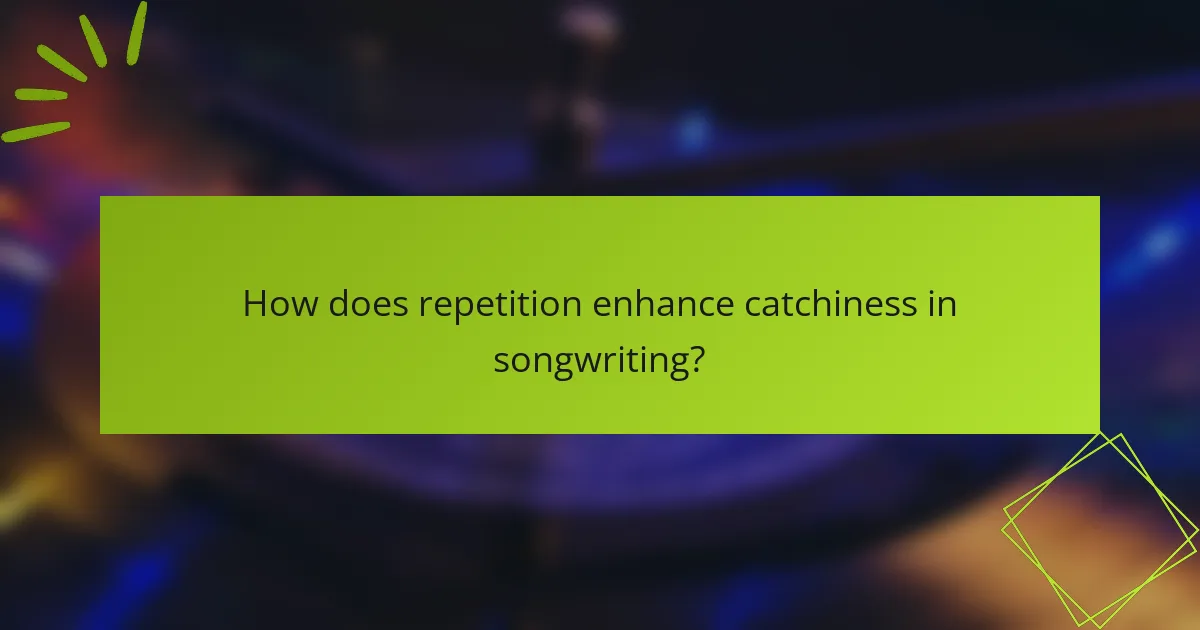
How does repetition enhance catchiness in songwriting?
Repetition enhances catchiness in songwriting by embedding memorable phrases and melodies into the listener’s mind. This technique makes songs more engaging and easier to remember, ultimately increasing their appeal and potential for success.
Repetition creates memorable hooks
Memorable hooks are often the backbone of a catchy song, and repetition plays a crucial role in their effectiveness. By repeating a catchy phrase or melody, songwriters can ensure that listeners remember it long after the song ends. For example, many pop songs utilize a repeated chorus that sticks in the listener’s mind, making it instantly recognizable.
To create effective hooks, consider using simple, rhythmic phrases that are easy to sing along with. Aim for a balance between familiarity and novelty to keep the listener engaged while ensuring the hook remains memorable.
Repetition reinforces emotional impact
Repetition can amplify the emotional weight of a song by emphasizing key themes or feelings. When a particular line or melody is repeated, it can evoke stronger emotional responses from the audience, making the song more relatable. For instance, a repeated lyric about heartbreak can resonate deeply with listeners, enhancing their connection to the music.
To maximize emotional impact, choose phrases that encapsulate the song’s core message and repeat them strategically throughout the track. This technique not only reinforces the theme but also helps listeners internalize the emotions conveyed.
Repetition aids listener recall
Repetition significantly aids listener recall by making it easier for audiences to remember lyrics and melodies. When a song features repeated elements, it creates a sense of familiarity that encourages listeners to sing along or hum the tune later. This is particularly effective in genres like pop and rock, where catchy choruses are essential.
To enhance recall, consider repeating key lines or melodies at various points in the song, such as the bridge or final chorus. This approach not only reinforces the song’s main ideas but also increases the likelihood that listeners will share the track with others, further boosting its popularity.
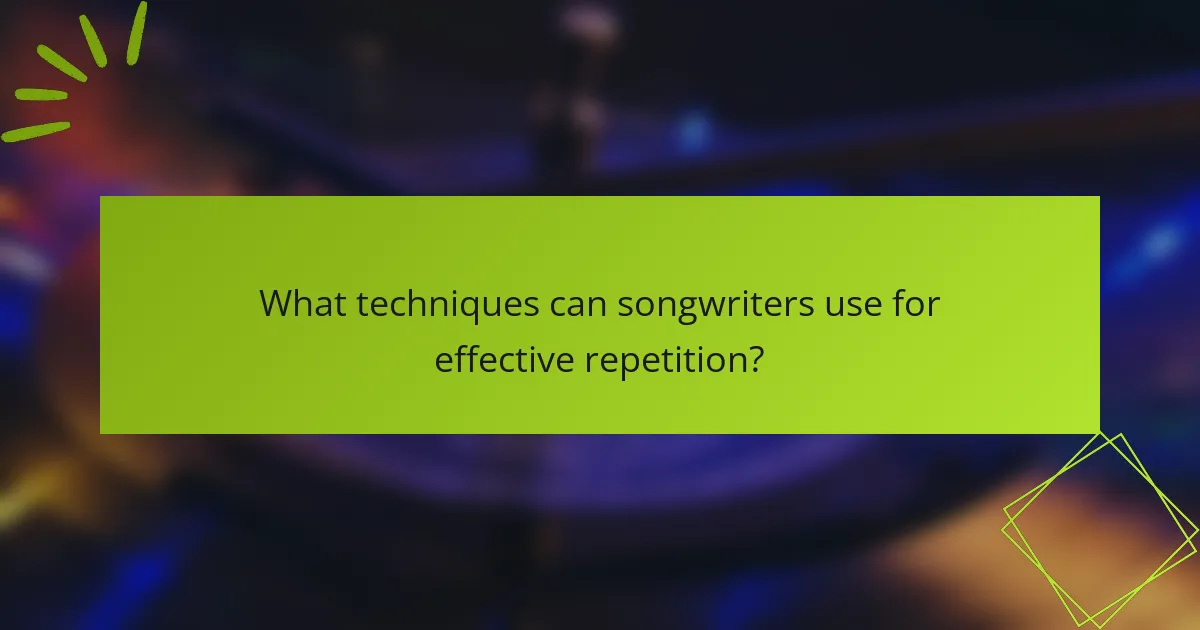
What techniques can songwriters use for effective repetition?
Songwriters can employ various techniques for effective repetition that enhance a song’s catchiness and memorability. Key methods include chorus repetition, motif variation, and call and response, each contributing uniquely to a song’s structure and listener engagement.
Chorus repetition
Chorus repetition involves repeating the same lines or phrases in the chorus to create familiarity and emotional impact. This technique helps anchor the song in the listener’s mind, making it easier to remember and sing along.
When crafting a chorus, aim for a simple and catchy melody that can be easily repeated. Popular songs often feature choruses that are repeated multiple times, sometimes four to six times throughout the track, reinforcing the main theme.
Be cautious of overusing repetition, as it can lead to predictability. Strive for a balance that keeps the chorus fresh while maintaining its catchy essence.
Motif variation
Motif variation involves altering a recurring musical phrase or lyrical line to maintain listener interest while still providing a sense of familiarity. This technique can include changing the melody, rhythm, or even the lyrics slightly each time the motif appears.
For example, a songwriter might introduce a motif in the verse, then modify it in the chorus by adding harmonies or changing the instrumentation. This keeps the song dynamic and engaging while reinforcing the core idea.
When using motif variation, ensure that the changes are subtle enough to maintain coherence but distinct enough to capture attention. A good rule of thumb is to vary around 20-30% of the original motif to keep it recognizable yet fresh.
Call and response
Call and response is a technique where one musical phrase (the call) is followed by a contrasting phrase (the response). This interaction creates a dialogue within the song, engaging listeners and encouraging participation.
This method is often seen in genres like blues, gospel, and hip-hop, where the lead vocalist might sing a line, and the backing vocalists or audience respond with a repeated phrase. Incorporating call and response can enhance the live performance aspect of a song, making it more interactive.
To effectively implement call and response, ensure that the call is clear and concise, while the response is catchy and easy to remember. Aim for a back-and-forth dynamic that feels natural, and consider using it in key moments of the song to heighten emotional impact.
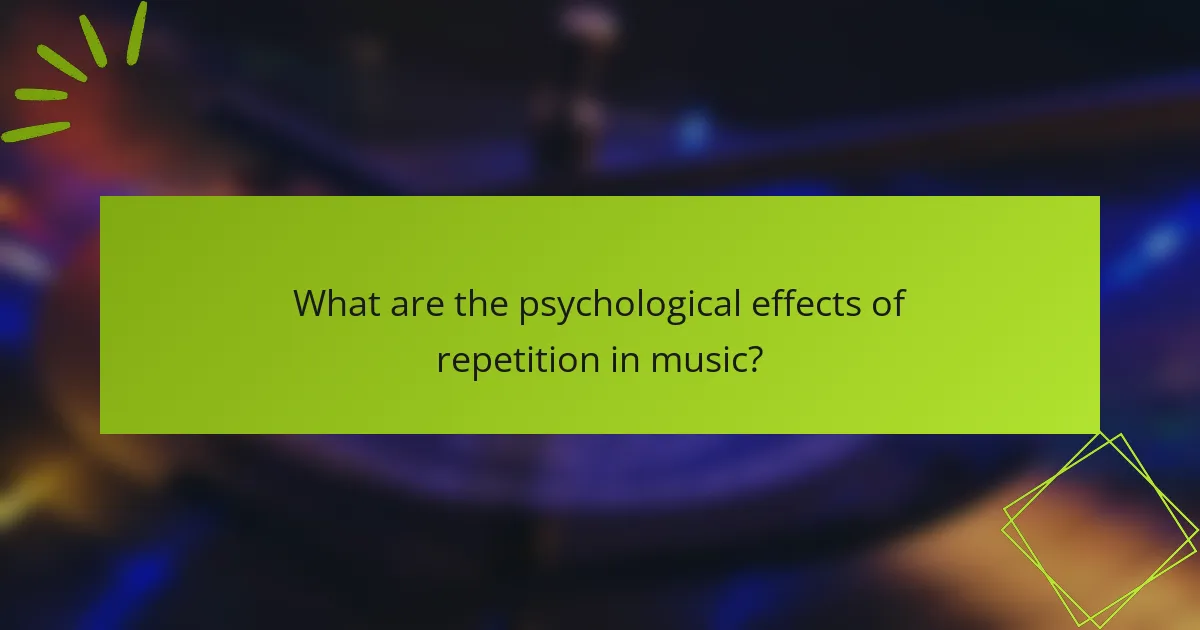
What are the psychological effects of repetition in music?
Repetition in music significantly influences listeners’ psychological responses, enhancing familiarity, emotional connection, and behavior. By creating a sense of predictability, repetition can make songs more memorable and engaging.
Increases familiarity and comfort
Repetition fosters familiarity, which can lead to increased comfort for listeners. When a musical phrase or hook is repeated, it becomes recognizable, allowing the audience to anticipate what comes next. This predictability can make the listening experience more enjoyable and less daunting.
For songwriters, using repeated elements like choruses or motifs can help solidify a song’s identity. A well-placed refrain might be repeated several times throughout a track, reinforcing its presence and making it easier for listeners to recall the song later.
Enhances emotional engagement
Repetition can heighten emotional engagement by reinforcing the feelings conveyed in a song. When key phrases or melodies are repeated, they can amplify the emotional weight of the lyrics and music. This technique allows listeners to connect more deeply with the song’s message.
For instance, a poignant lyric repeated at crucial moments can evoke stronger feelings, making the song resonate more with the audience. Songwriters should consider strategically placing emotional lines or melodies to maximize their impact through repetition.
Influences listener behavior
The psychological effects of repetition can also influence listener behavior, such as encouraging sing-alongs or increasing song downloads. Familiarity often leads to a greater likelihood of sharing or recommending a song, as listeners feel a connection to what they know.
To leverage this, songwriters might incorporate catchy hooks or phrases that are easy to remember and sing. This can enhance the song’s reach and popularity, as repeated exposure often leads to increased acceptance and preference among listeners.
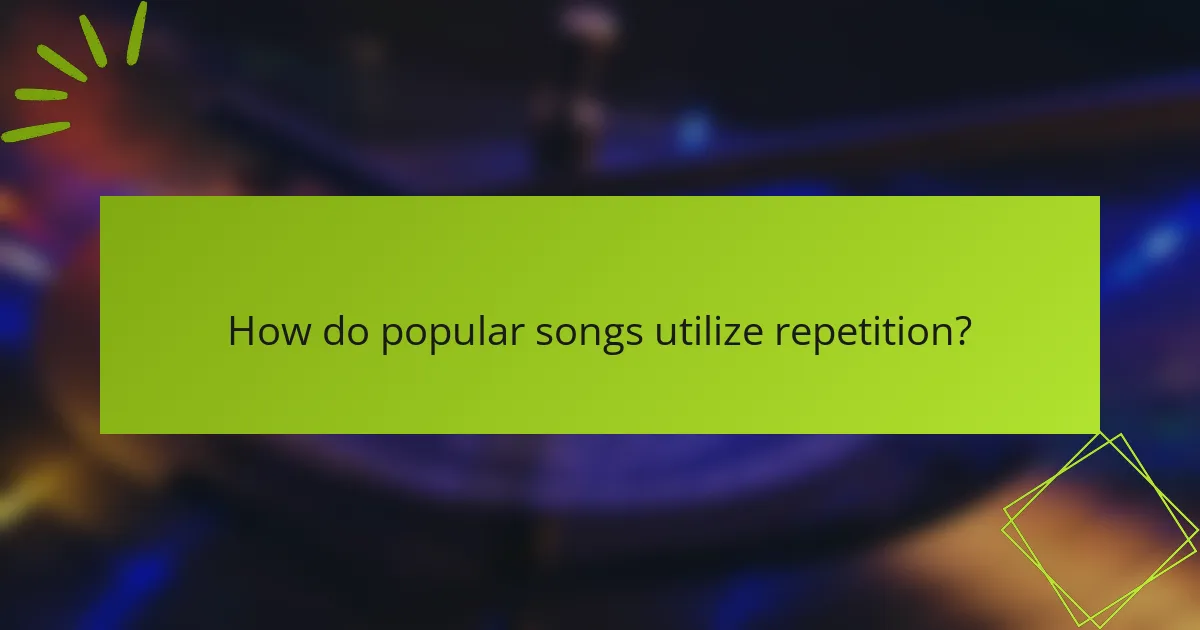
How do popular songs utilize repetition?
Popular songs often use repetition to create memorable hooks and enhance emotional impact. This technique helps listeners engage with the music and makes the songs easier to remember and sing along to.
Examples from Taylor Swift
Taylor Swift frequently employs repetition in her choruses to emphasize key themes and emotions. For instance, in “Shake It Off,” the repeated phrase “shake it off” reinforces the message of resilience against criticism.
Another example is “Blank Space,” where the chorus repeats the line “Got a long list of ex-lovers,” creating a catchy and relatable hook that resonates with listeners. This use of repetition not only makes the song catchy but also drives home the narrative of the lyrics.
Examples from Ed Sheeran
Ed Sheeran’s song “Shape of You” showcases repetition through its infectious chorus, where the phrase “I’m in love with the shape of you” is repeated multiple times. This repetition helps to establish a rhythmic flow that keeps listeners engaged.
In “Castle on the Hill,” Sheeran uses the repeated line “I’m on my way” to evoke a sense of nostalgia and longing. This technique not only enhances the song’s catchiness but also deepens the emotional connection with the audience.
Examples from Drake
Drake often utilizes repetition to create memorable hooks, as seen in “God’s Plan,” where the phrase “I only love my bed and my momma” is repeated, making it instantly recognizable. This repetition aids in reinforcing the song’s themes of loyalty and personal priorities.
In “In My Feelings,” the repeated question “Kiki, do you love me?” serves as a catchy hook that encourages listener participation. This technique not only enhances the song’s appeal but also invites fans to engage with the lyrics in a playful manner.
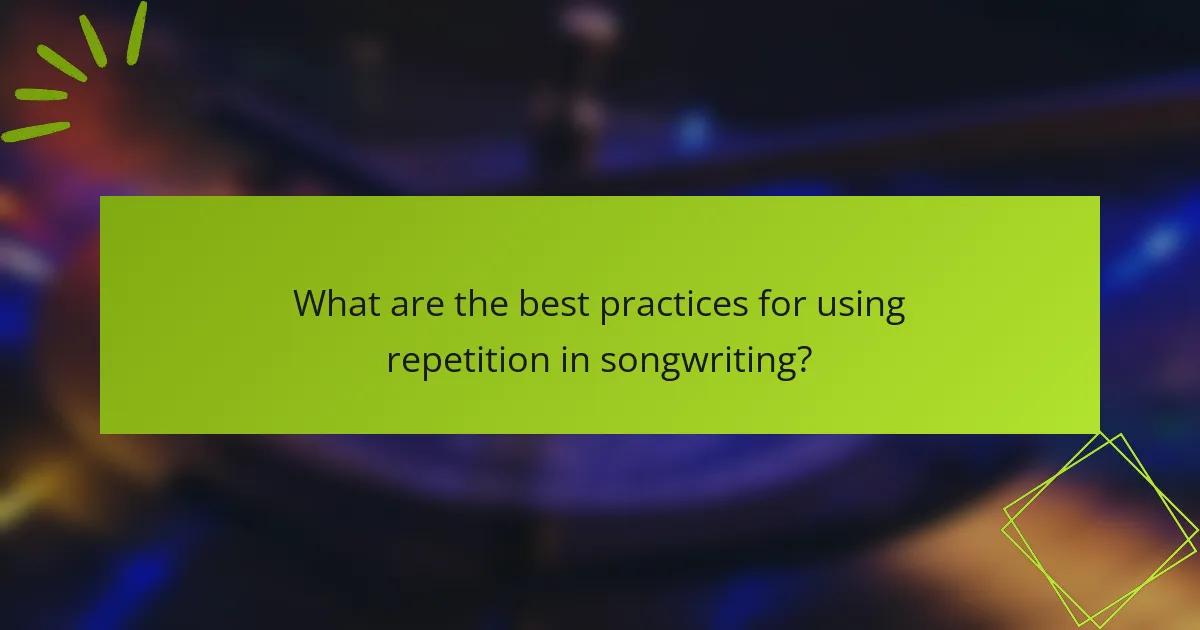
What are the best practices for using repetition in songwriting?
Effective use of repetition in songwriting enhances catchiness and memorability. Best practices include finding the right balance between repeating phrases, ensuring lyrical clarity, and adhering to genre-specific norms.
Balance between repetition and variation
Striking a balance between repetition and variation is essential for maintaining listener interest. Too much repetition can lead to monotony, while too little may fail to create a memorable hook. Aim for a structure where key phrases or melodies are repeated, but introduce slight variations to keep the song dynamic.
For instance, consider repeating a chorus with different instrumentation or vocal delivery. This approach can refresh the listener’s experience while reinforcing the song’s core message. A common practice is to repeat a hook several times, perhaps three to four, while varying verses to maintain engagement.
Focus on lyrical clarity
Lyrical clarity is crucial when employing repetition, as it ensures that the message resonates with the audience. Repeated lines should be straightforward and impactful, allowing listeners to easily grasp the song’s theme. Avoid overly complex language that may confuse or dilute the meaning.
For example, a catchy refrain that uses simple, relatable phrases can enhance emotional connection. Aim for repetition that emphasizes key emotions or ideas, making them memorable and singable. A good rule of thumb is to keep repeated lines concise, ideally no longer than a few words or a short phrase.
Consider genre-specific norms
Different music genres have unique conventions regarding repetition. Pop music often relies heavily on catchy hooks and repetitive choruses, while genres like jazz or classical may favor variation and improvisation. Understanding these norms can guide your songwriting process and help you meet audience expectations.
For instance, in hip-hop, repetition can be used effectively in verses to emphasize rhythm and flow, while country music may focus on storytelling with repeated choruses that reinforce the narrative. Researching popular songs within your chosen genre can provide insights into effective repetition techniques that resonate with listeners.
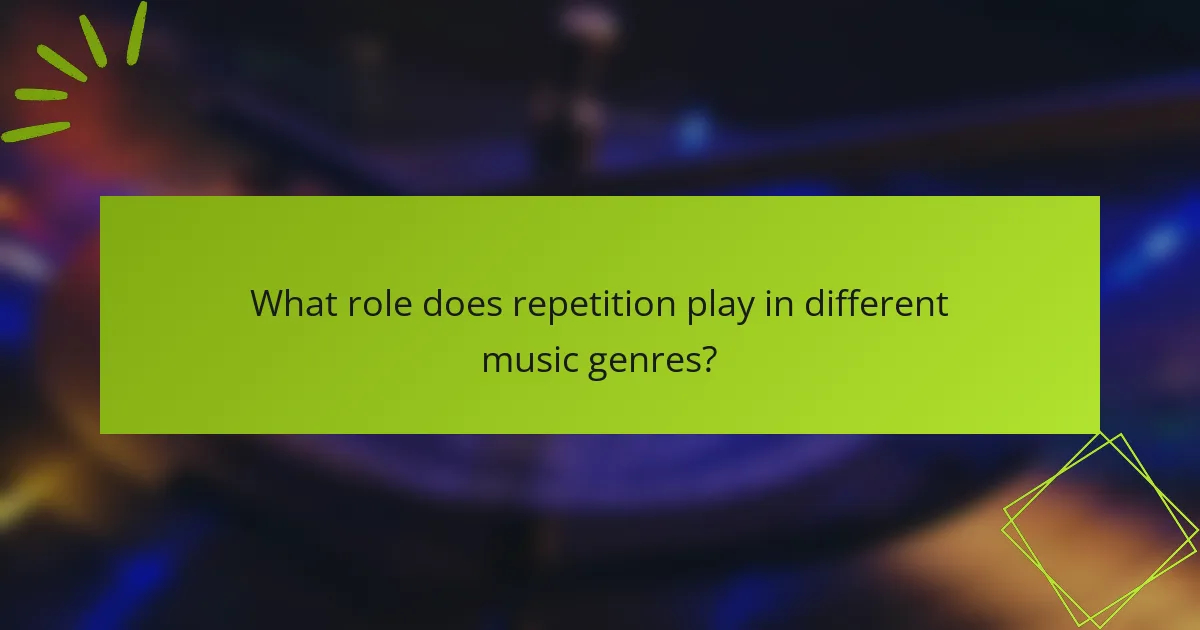
What role does repetition play in different music genres?
Repetition is a fundamental element in various music genres, enhancing memorability and emotional impact. It helps create hooks that resonate with listeners, making songs more engaging and easier to remember.
Pop Music
In pop music, repetition is often used to establish catchy choruses that stick in the listener’s mind. Artists frequently repeat phrases or melodies to create a sense of familiarity, which can lead to increased radio play and streaming. For example, many pop hits feature a simple, repetitive hook that is repeated multiple times throughout the song.
Common techniques include the use of a repeated chorus or a catchy refrain, which can be effective in building anticipation and excitement. This approach not only makes the song more enjoyable but also encourages sing-alongs, further embedding the song in popular culture.
Hip-Hop
In hip-hop, repetition serves to emphasize key themes or messages within the lyrics. Repeated phrases can create a rhythmic flow that enhances the overall beat and makes the lyrics more impactful. Many hip-hop tracks feature hooks that are repeated several times, reinforcing the song’s main idea.
Additionally, artists often use call-and-response techniques, where a repeated line invites audience participation. This interaction can create a dynamic live performance atmosphere, making the song memorable and engaging for listeners.
Rock Music
Repetition in rock music often manifests through repeated riffs or choruses, which can drive the song’s energy and intensity. Iconic guitar riffs are frequently repeated to create a signature sound that defines the track. This technique helps to establish a strong identity for the song and can make it instantly recognizable.
Moreover, rock anthems often utilize repetition to evoke strong emotions, whether it be through powerful choruses or repeated lyrical phrases that resonate with listeners. This can lead to a deeper connection with the audience, as they find themselves singing along and feeling the music’s energy.
Electronic Dance Music (EDM)
In EDM, repetition is a key component of building tension and creating drops that energize the crowd. Producers often repeat melodic phrases or beats to create a hypnotic effect, drawing listeners into a trance-like state. This technique is essential for maintaining the dance floor’s energy and encouraging movement.
Repetitive structures, such as build-ups followed by drops, are common in EDM tracks. This pattern not only enhances the listening experience but also allows DJs to seamlessly mix tracks during live performances, keeping the audience engaged and excited.
